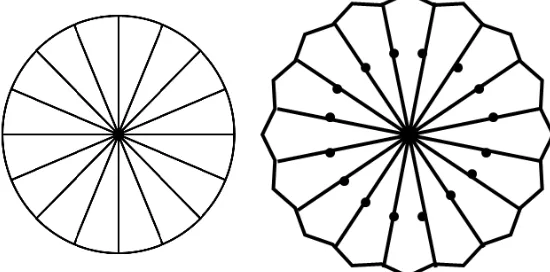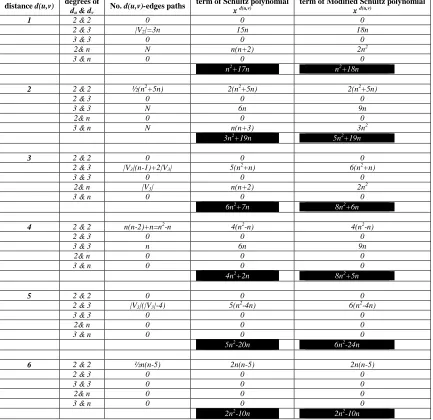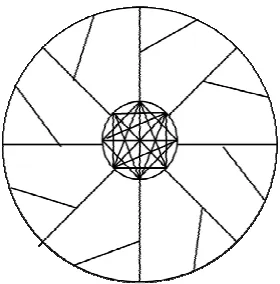Journal of Chemical and Pharmaceutical Research, 2016, 8(3):51-57
Research Article
CODEN(USA) : JCPRC5
ISSN : 0975-7384
The Schultz and modified Schultz polynomials of certain subdivision and line
subdivision graphs
Mohammad Reza Farahani
1and Muhammad Kamran Jamil
2*1Department of Applied Mathematics of Iran University of Science and Technology (IUST), Narmak, Tehran 16844,
Iran
2Abdus Salam School of Mathematical Sciences, Government College University, Lahore, Pakistan
_____________________________________________________________________________________________
ABSTRACT
For a connected graph G(V(G),E(G)), du and d(u,v) represents the degree of u and the distance between u and v.
Ivan Gutman defined the Schultz and modified Schultz polynomials as ( , )
{ , } ( )
( , )
(
u v)
d u v u v V GSc G x
d
d x
⊆
=
∑
+
and( , )
{ , } ( )
* ( , )
u v d u v u v V GSc
G x
d d x
⊆
=
∑
, respectively. Such that their first derivative at x=1 are equal to{ , } ( )
( )
(
u v) ( , )
u v V GSc G
d
d d u v
⊆
=
∑
+
and{ , } ( )
* ( )
(
u v) ( , )
u v V GSc
G
d d d u v
⊆
=
∑
, respectively, which are theSchultz index and its modification. In this paper, we compute the Schultz and modified Schultz polynomials and their corresponding indices of the subdivision graph and the line graph subdivision graph of wheel graph.
Keywords: Topological indices, Schultz indices, Schultz polynomial, subdivision graph, line graph.
Mathematics Subject Classification; 05C05, 05C12, 05C15, 05C31, 05C69.
_____________________________________________________________________________________________
INTRODUCTION
Let G(V(G),E(G)) be a simple connected graph, where the V(G) and E(G) are the vertex and edge sets, respectively, of G. For vertices
u v V G
,
∈
( )
, u is adjacent to v if they are connected by an edge. The degree of a vertex u, du, isthe number of vertices adjacent to u. The distance between u and v, d(u,v), is the number of edges in a shortest path connecting them. The largest distance between any two vertices of a graph G is called the diameter of G, denoted as d(G).
The subdivision graph is the graph obtained by inserting an additional vertex into each edge of G, denoted as S(G). The line graph, of a graph G is the graph whose vertices are the edges of the graph G, and two vertices e and f are incident if and only if they are adjacent in G, denoted as L(G). A wheel graph with n vertices is a graph formed by connecting a single vertex to all vertices of a cycle, denoted as Wn. It has 2(n-1) edges. For further study and results
we refer [21-23].
Distance is an important concept in graph theory and it has numerous applications in computer science, biology, chemistry and a variety of other fields. Using the concept of distances in a graph G, H. Wiener defined a descriptor for explaining the boiling points of paraffins [1]
{ , } ( )
( )
( , )
u v V G
W G
d u v
⊆
This descriptor is known as Wiener index. A topological index is a real number related to a structural graph of a molecule, and it does not depend on the labelling or pictorial representation of a graph. A lot of topological indices have been introduced, Wiener index is one of the topological indices that correlate with some of the physico-chemical properties of the compound [2,3].
Harry Shultz [5] introduced another distance based topological index known as Shultz index
{ , } ( )
( )
(
u v) ( , )
u v V GSc G
d
d d u v
⊆
=
∑
+
The Schultz index is closely related to the Wiener index in the case of trees with relation
( )
4
( )
(
1)
S G
=
W G
−
n n
−
[6]. Gutman et. al. [7] defined the modified Schultz index as{ , } ( )
* ( )
(
u v) ( , )
u v V GSc
G
d d d u v
⊆
=
∑
This topological index also closely related to Wiener index with relation [8].
* ( )
4
( )
(2
1)
Sc
G
=
W G
−
n n
−
H. Hosoya [4] introduced a distance-based polynomial to generate distance distributions for graphs, called the Wiener polynomial
( , )
{ , } ( )
( , )
d u v u v V GH G x
x
⊆
=
∑
The first derivative of H(G,x) at x=1 is equal to Wiener index of G. Gutman [9] introduced new polynomials called the Schultz polynomial and the modified Schultz polynomial as
( , )
{ , } ( )
( , )
(
)
d u v u v u v V GSc G x
d
d x
⊆
=
∑
+
( , )
{ , } ( )
* ( , )
u v d u v u v V GSc
G x
d d x
⊆
=
∑
Such that their derivative at x=1 are equal to the Schultz and modified Schultz indices. He also obtained some connection between these polynomials and Wiener polynomial of trees. For further details we refer [10-20].
RESULTS AND DISCUSSION
In this section, we compute the Schultz and modified Schultz polynomials and their corresponding Schultz and modified Schultz topological indices of subdivision graph of the wheel graph S(Wn) and the line graph subdivision
graph of the wheel graph L(S(Wn)).
Theorem 1. Let S(Wn) be the subdivision graph of the wheel graph with order n≥3. Then, • The Schultz polynomial and index of S(Wn) are equal to
Sc(S(Wn),x)=(n2+17n)x+(3n2+19n)x2+(6n2+7n)x3+(4n2+2n)x4+(5n2-20n)x5+(2n2-10n)x6.
The definition of the subdivision graph of the wheel graph Wn and from Figure 1, the size of these three vertex
sub-sets are |V2|=2n, |V3|=n and |Vn|=1 and the number of edges of S(Wn)is equal to
|E(S(Wn))|=½[2×|V2|+3×|V3|+n×|Vn|]= 2 2 3 1
2 n n n
× + × + × =4n.
From Figure 1, we see that there are distances between vertices of the subdivision graph of the wheel graph Wn are
up to six and the diameter of S(Wn) is equal to d(S(Wn))=6. In other words for every vertices u,v
∈
V(S(Wn)) ; ∃d(u,v)∈{1,2,...,6}.Now, from the structure of the subdivision graph of the wheel graph S(Wn) (see Figure 1), we compute all terms of
the Schultz polynomial, Modified Schultz polynomial of S(Wn), based on the number of
d(u,v) ∀v,u∈V(S(Wn)).
Here consider d(u,v)=1 (∀v,u∈V(S(Wn))), so from the edge set E(S(Wn)), we see that there are n path with length one
or n edges cv∈E(S(Wn)) for only vertex c∈Vn⊂V(S(Wn)) and a vertex v∈V2⊂V(S(Wn)) that dc+dv=n+2 and
dc×dv=2n. For a vertex u∈V3⊂V(S(Wn)), there are 3 path with length one until a vertex v∈V2 or 3n edges
uv∈E(S(Wn)) such that du=3, dv=2 and alternatively du+dv=5 & du×dv=6. Therefore the first terms of the Schultz
and Modified Schultz polynomials of S(Wn) will be n(n+2)x+3n(5)x=(n2+17n)x and n(2n)x+3n(6)x=(2n2+18n)x, respectively.
In case d(u,v)=2 {v,u}⊂V(S(Wn)); there are n 2-edges paths between Center vertex c∈Vn and vertices from
V3⊂V(S(Wn)), there are ½(2|V3|)=n 2-edges paths between all vertices u,v∈V3 that du+dv=6 & du×dv=9. Finally
there are ½[2n+n(n-1)+4n]=½(n2+5n) 2-edges paths between all vertices uv from V2⊂V(S(Wn)), such that
du+dv=du×dv=4. Then the second terms of the Schultz and Modified Schultz polynomials of S(Wn) are equal to
[6×n+(n+3)×n+4×½(n2+5n)]x2=(3n2+19n)x2 and [9×n+(3n)×n+4×½(n2+5n)]x2 =(5n2+19n)x2, respectively.
Here, we can compute all other terms of the Schultz and Modified Schultz polynomials of S(Wn) by using the
[image:3.595.170.445.432.568.2]definition of the subdivision graph of the wheel graph (Figure 1). Thus, we present all coefficients and terms of the Schultz and Modified Schultz polynomials of S(Wn) in Table 1 (for all d(u,v)∈{1,2,...,6}).
Table 1. all coefficients and terms of the Schultz and Modified Schultz polynomials of S(Wn) ∀d(u,v)∈{1,2,...,6} & u,v∈ V(S(Wn))
distance d(u,v) degrees of
du & dv No. d(u,v)-edges paths
term of Schultz polynomial
x d(u,v)
term of Modified Schultz polynomial
x d(u,v)
1 2 & 2 0 0 0
2 & 3 |V2|=3n 15n 18n
3 & 3 0 0 0
2& n N n(n+2) 2n2
3 & n 0 0 0
n2+17n n2+18n
2 2 & 2 ½(n2+5n) 2(n2+5n) 2(n2+5n)
2 & 3 0 0 0
3 & 3 N 6n 9n
2& n 0 0 0
3 & n N n(n+3) 3n2
3n2+19n 5n2+19n
3 2 & 2 0 0 0
2 & 3 |V3|(n-1)+2|V3| 5(n2+n) 6(n2+n)
3 & 3 0 0 0
2& n |V3| n(n+2) 2n2
3 & n 0 0 0
6n2+7n 8n2+6n
4 2 & 2 n(n-2)+n=n2-n 4(n2-n) 4(n2-n)
2 & 3 0 0 0
3 & 3 n 6n 9n
2& n 0 0 0
3 & n 0 0 0
4n2+2n 8n2+5n
5 2 & 2 0 0 0
2 & 3 |V3|(|V3|-4) 5(n2-4n) 6(n2-4n)
3 & 3 0 0 0
2& n 0 0 0
3 & n 0 0 0
5n2-20n 6n2-24n
6 2 & 2 ½n(n-5) 2n(n-5) 2n(n-5)
2 & 3 0 0 0
3 & 3 0 0 0
2& n 0 0 0
3 & n 0 0 0
2n2-10n 2n2-10n
Now, from Table 1, we see the Schultz, Modified Schultz polynomials of the subdivision graph of the wheel graph S(Wn)are equal to:
Sc(S(Wn),x)=½
( )
( )
,
u v V S Wn∈
∑
(du+dv)xd(u,v)Sc*(S(Wn))=
( )
1
*
(
,
)
x
Sc
S W n
x
x
=∂
∂
=
x
∂
∂
(n2+18n)x+(5n2+19n)x2+(8n2+6n)x3+(8n2+5n)x4+(6n2-24n)x5+(2n2-10n)x6
1
x=
=(n2+18n)×1+(5n2+19n)×2+(8n2+6n)×3+(8n2+5n)×4+(6n2-24n)×5+(2n2-10n)×6 =109n2-86n.
Thus, this completed the proof of Theorem 1. ■
Theorem 2. Let L(S(Wn)) be the line graph of the subdivision graph of the wheel graph. Then, • The Schultz polynomial and index of L(S(Wn)) are equal to
Sc(L(S(Wn)),x)=(2n3+27n)x+(n3+4n2+27n)x2+(2n3+7n2+15n)x3+(12n2-24n)x4+(6n2-54n)x5
Sc(L(S(Wn)))=10n 3
+107n2-240n.
• The Modified Schultz polynomial and index of L(S(Wn)) are equal to
Sc*(L(S(Wn)),x)=(½n4-½n3+3n2+36n)x+(3n3+3n2+36n)x2+½(12n3-3n2+63n)x3+(18n2-36n)x4+(9n2-81n)x5
Sc*(L(S(Wn)))=½n4+7n3+
243
2
n2-252n.Proof. Consider L(S(Wn)) as the line graph of the subdivision graph of the wheel graph “Wn” with order ∀n≥3. From
the definitions of subdivision and line graphs in Section 1, we see that a general form of L(S(Wn)) |V(L(S(Wn)))|=4n
vertices and |E(L(S(Wn)))|=½n(n+9) edges. Also, from Figure 2, we see that L(S(Wn)) has n vertices with degree n
and 3n vertices with degree 3. In other words, we have two sub-sets of V(L(S(Wn))) as follow:
Vn={v∈V(L(S(Wn)))| dv=n}
V3={v∈V(L(S(Wn)))|dv=3}
Such that V(L(S(Wn)))=Vn⋃V3 & |Vn|=n and |V3|=3n (|E(L(S(Wn)))|=½(3|V3|+n|Vn|)=½n(n+9).
Here from Figure 2, one can see that the diameter of L(S(Wn)) is equal to five (the diameter d(G) of G is the longest
topological distance between vertices in V(G).). Obviously ∀u,v∊V(L(S(Wn))); d(u,v) is equal to 1,2,...,5.
Now, similar to proof of Theorem 1, we compute all terms of the Schultz polynomial, Modified Schultz polynomial of the line graph of the subdivision graph of the wheel graph by using the number of d(u,v) for all pairs of u,v∊V(L(S(Wn))). Thus, we present all cases d(u,v)∈{1,2,...,5} ∀{v,u}⊂ V(L(S(Wn))) of L(S(Wn)) in Table 1 by using
[image:5.595.236.376.526.668.2]the definitions of subdivision and line graphs and the general representation of L(S(Wn)) in Figure 2.
Table 2. All coefficients and terms of the Schultz and Modified Schultz polynomials of L(S(Wn)) ∀d(u,v)=1,2,...,5
distance d(u,v) degrees of
du & dv
No. d(u,v)-edges paths term of Schultz polynomial
x d(u,v)
term of Modified Schultz polynomial
x d(u,v)
1 3 & 3 4n 24n 36n
3 & n n n2+3n 3n2
n & n |E(Kn)|=½(n2-n) n3-n2 ½n4-½n3
2n3+27n ½n4-½n3+3n2+36n
2 3 & 3 4n 24n 36n
3 & n n2+n n3+4n2+3n 3n3+3n2
n & n 0 0 0
n3+4n2+27n 3n3+3n2+36n
3 3 & 3 2n+½n(n-1)+2n
=½n(n+7) 3n
2+21n
9
2
n2
+
63
2
n3 & n 2n(n-1) 2n3+4n2-6n 6n3-6n2
n & n 0 0 0
2n3+7n2+15n
6n3-
3
2
n2
+
63
2
n4 3 & 3 n(n-2)+n(n-2) 12n2-24n 18n2-36n
3 & n 0 0 0
n & n 0 0 0
12n2-24n 18n2-36n
5 3 & 3 ½[2n(n-9)] 6n2-54n 9n2-81n
3 & n 0 0 0
n & n 0 0 0
6n2-54n 9n2-81n
For example, 1n case d(u,v)=1, we know that all 1-edge-paths of L(S(Wn)) are all edges of L(S(Wn)), clearly. And all
edges of the line graph S(Wn) are the 2-edge-paths of S(Wn). So by according to the proof of Theorem 1, we can
conclude the first terms of the Schultz and Modified Schultz polynomials of L(S(Wn)) of the second terms of the
Schultz and Modified Schultz polynomials of S(Wn) as follow:
[6×4n+(n+3)×n+(n+n)×½(n2-n) ]x2=(2n3+27n)x1
and
[9×4n+(3n)×n+(n2)×½(n2-n)]x2=(½n4-½n3+3n2+36n)x1
In case d(u,v)=2 {v,u}⊂V(L(S(Wn))); there are n2+n 2-edges paths between vertices of the vertex partition Vn and V3,
such that du+dv=n+3 & du×dv=3n. Also, n+n+2n 2-edges paths between all vertices of V3, that du+dv=6 & du×dv=9.
And these imply that the second terms of the Schultz and Modified Schultz polynomials of L(S(Wn)) be
[6×4n+(n+3)×(n2+n)]x2=(n3+4n2+27n)x2 and [9×4n+(3n)×(n2+n)]x2=(3n3+3n2+36n)x2, respectively.
Sc*(L(S(Wn)))=
( )
(
)
1
, )
* (
nx
Sc
L S W
x
x
=
∂
∂
=½n4+7n3+
243
2
n2-252n.
Here, the proof of Theorem 2 was completed. ■
REFERENCES
[1]H. Wiener, J. Am. Chem. Soc., 69 (1947) 17-20.
[2]A. A. Dobrynin, R. Entringer, I Gutman, Acta Appl. Math., 66 (2001) 211-249.
[3]I. Gutman, O. E. Polansky: Mathematical concepts in organic chemistry, Springer, Berlin, 1986. [4]H. Hosoya, Discrete Appl. Math., 19 (1988) 239-257.
[5]H. P. Schultz, J. Chem. Inf. Comput. Sci. 29 (1989) 227-228.
[6]D. J. Klein, Z. Mihalić, D. Plavšić, N. Trinjastić, J. Chem. Inf. Comput. Sci., 32 (1992) 304-305.
[7]I. Gutman, S. Klavzar, Disc. Appl. Math., 80 (1997) 73-81. [8]I. Gutman, J. Chem. Inf. Comput. Sci., 34 (1994) 1087-1089. [9]I. Gutman, Sciences mathematiques, 30 (2005) 1-7.
[10]M. Eliasi, B. Taeri, Appl. Anal. Discrete Math. 2 (2008) 285-296.
[11]F. Hassani, A. Iranmanesh, S. Mirzaie, MATCH Commun. Math. Comput. Chem. 69 (2013) 87-92. [12]M.R. Farahani, M.P. Vlad. On the Schultz, Studia UBB Chemia. 57(4), (2012), 55-63.
[13]M.R. Farahani, M.P. Vlad. On the Schultz, Studia UBB Chemia. 57(4), (2012), 55-63.
[14]M.R. Farahani. Hosoya, Schultz, International Journal of Theoretical Chemistry. 1(2), (2013), 09-16. [15]M.R. Farahani. Int. J. Applications of Discrete Mathematics. 1(1), (2013), 1-8.
[16]M.R. Farahani. J. Applied Math. & Info. 31(5-6), (2013). 595-608.
[17]M.R. Farahani. Pacific Journal of Applied Mathematics. 6(3), (2014), 77-84.
[18]M.R. Farahani, Wei Gao & M.R. Rajesh Kanna. Asian Journal of Applied Sciences. 2015, 3(6), 823-827. [19]M.R. Farahani, Wei Gao. Applied Mathematics. 6, 2015, 2319-2325.
[20]M.R. Farahani, M.R. Rajesh Kanna and Wei Gao.. Journal of Chemical, Biological and physical sciences 6(1),
2016, 294-301.
[21]G. Su, L. Xu, Applied Mathematics and Computation 253 (2015) 395-401.



